RETURN TO ARTICLE LIST
Competitive Concepts: Championship Points (+ Elo Deep Dive)
Written by Ver
Created 20 June, 2024
Last updated 20 June, 2024

Welcome back to Competitive Concepts! Today, we're taking a look at Omnidex and the Championship Points System. Let's dive in and discuss how you can rank up and earn those sweet sweet end of season rewards!
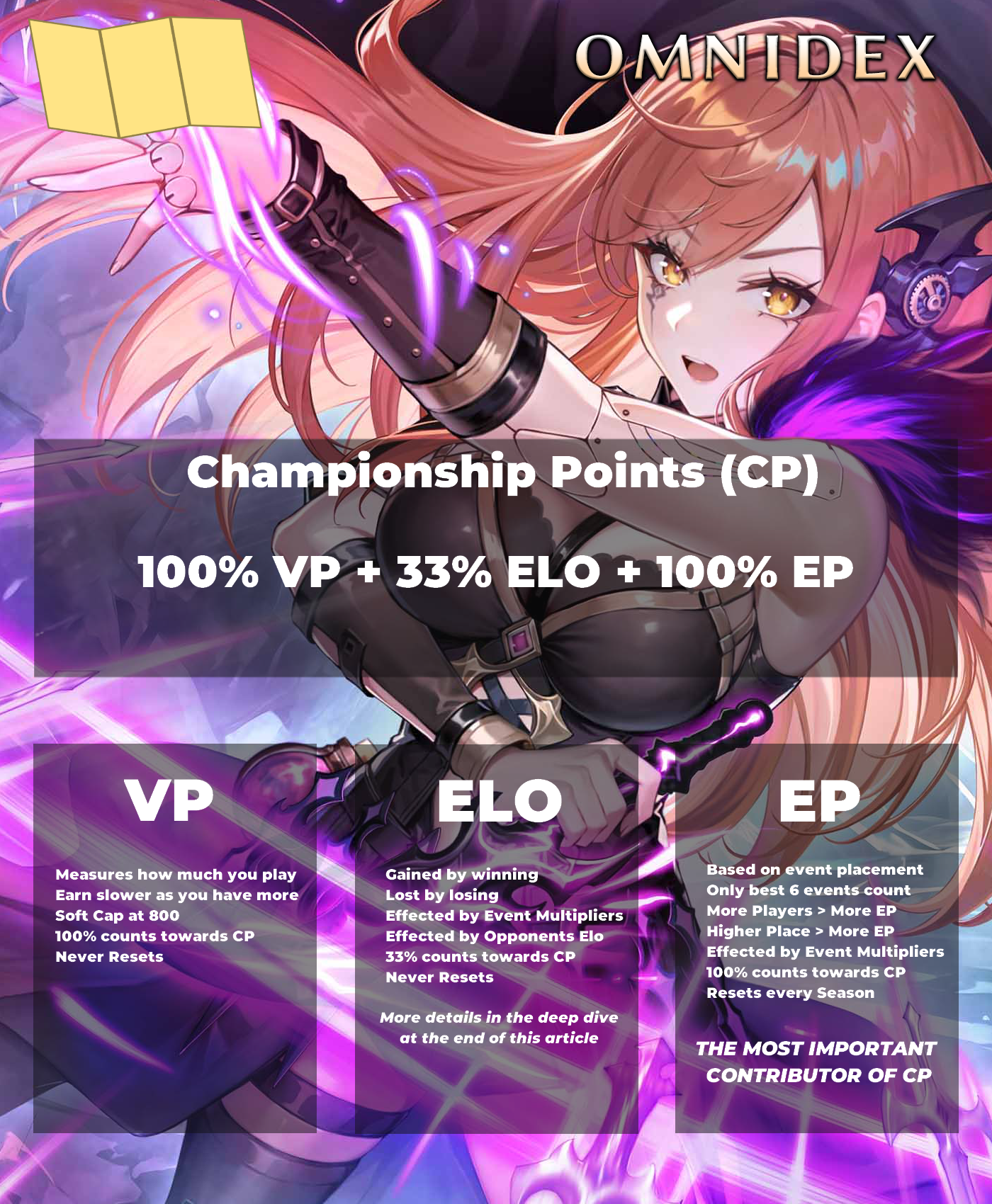
Championship Points are used to determine player ranking and end of season Omnidex rewards. You earn points towards 3 categories when you participate in ranked events hosted on Omnidex: Veterancy (VP), Elo and Event Points (EP).
Veterancy (VP) is a measure of how much you have played in Ranked events over the entire course of your player career. The more you play, the higher your VP will climb. Early on, VP is easy to earn, but as you approach the soft cap of 800 VP you will need to play more matches per VP gained. Above 800 VP, gains are expected to be incredibly slow, taking hundreds of matches to earn another point or two. Your VP contributes 100% towards your total Championship Points and never resets.
Elo is a player skill ranking system. Originating from Chess, players are assigned a ranking which predicts match outcomes, and match outcomes are used to update the rankings. New accounts are assigned an Elo rating of 1200. Elo is gained from winning matches and lost by losing matches. Draws result in Elo transferring from the higher rated player to the lower rated one. Event multipliers impact how quickly your Elo can change. 33% of your Elo is added to your total Championship Points. Elo never resets.
Event Points (EP) are based on event placement. Events with more players award more points, and better placements are worth more than lower ones. EP awarded also scales with the event multiplier. Your EP each season only counts the 6 events worth the most points. When you participate in an event and earn more points than the lowest of your current top 6 events, the new event will replace the older, lower valued event. 100% of your EP is added to your total Championship Points. EP is reset at the end of each season.
In the Alchemical Revolution season, EP accounted (on average) for 55% of the total Championship Point totals of the players in Top 100! Likewise, VP accounted for 25% and Elo for 20%. EP is by far the most important score to improve for your overall Championship Points!
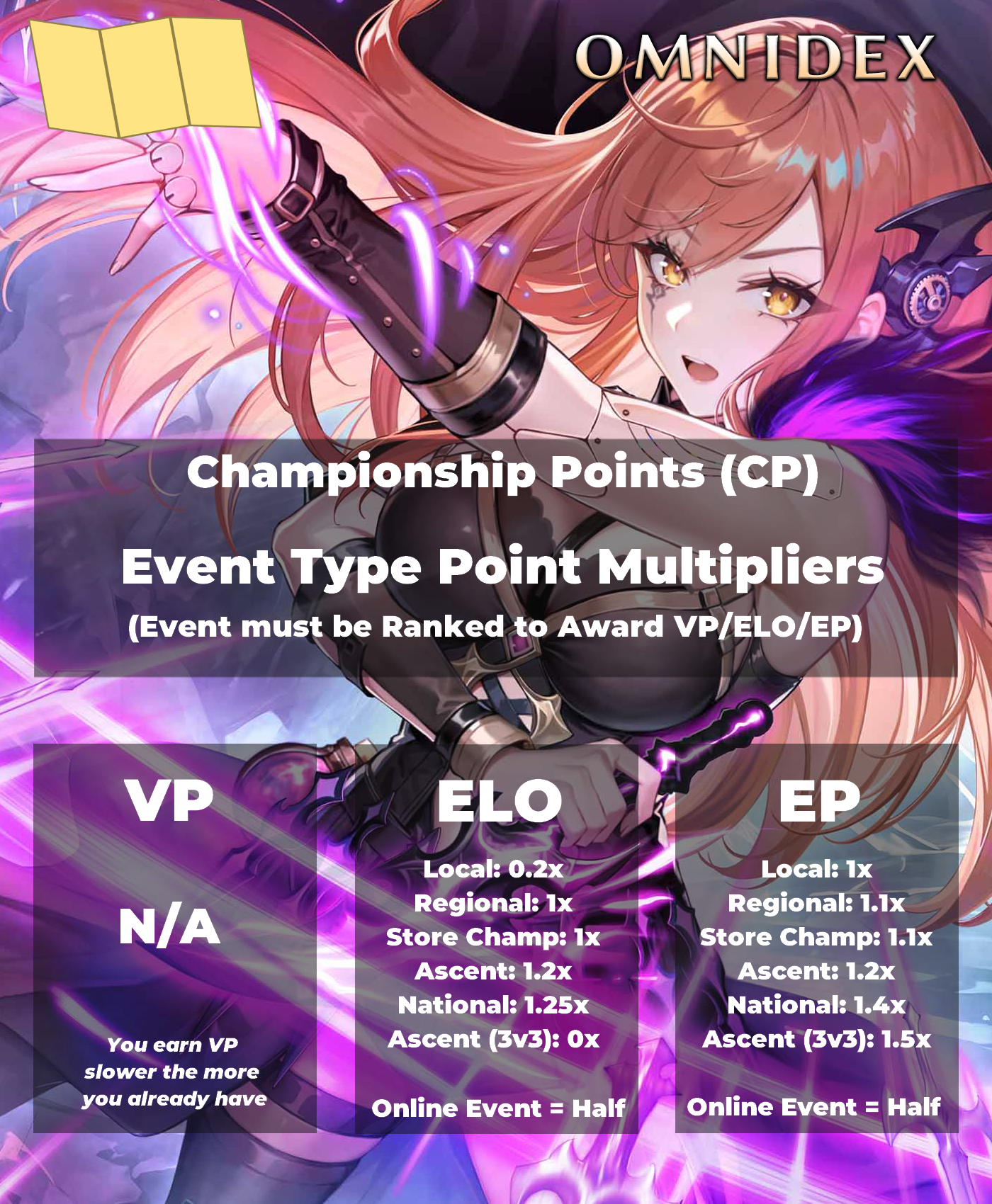
Every ranked event will have a multiplier for how much EP you can earn and how quickly your Elo can change. Generally speaking, Locals will award the least points and premier events award the most points. Points multipliers are halved for online events compared to their in person counterparts, to incentivize play at in person events when possible. Veterancy is not impacted by the event type.
Teams Standard (3v3) events have somewhat unusual Elo and EP multipliers. Elo is multiplied by 0, as Elo is designed to account for skill in head to head matches. EP is multiplied by a whopping 1.5x, however the amount of players in an event also impacts the points earned. For 3v3, each team is considered a "player" for point calculations. The 1.5x factor is there to offset the reduced points resulting from a lower "player" count.
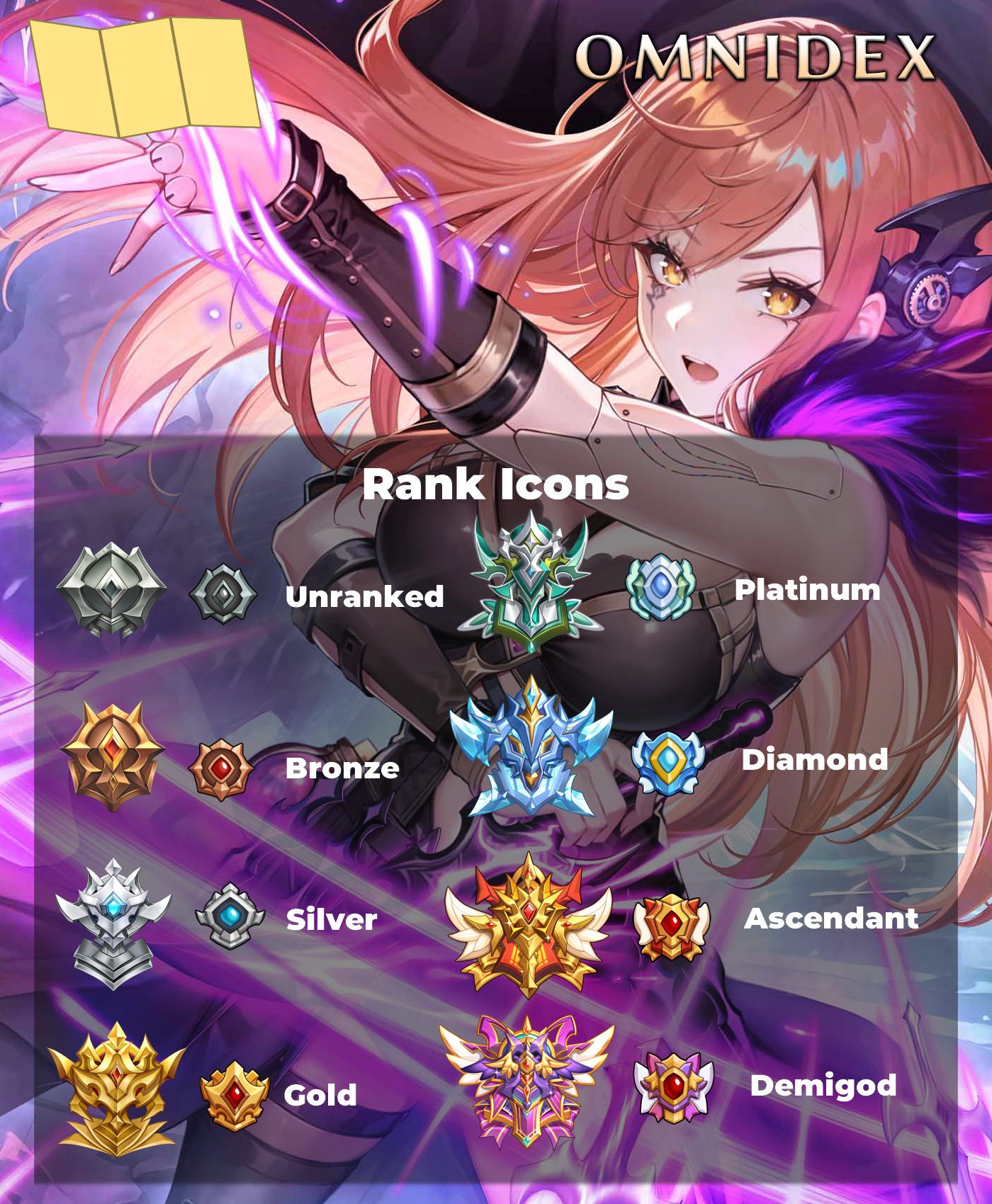
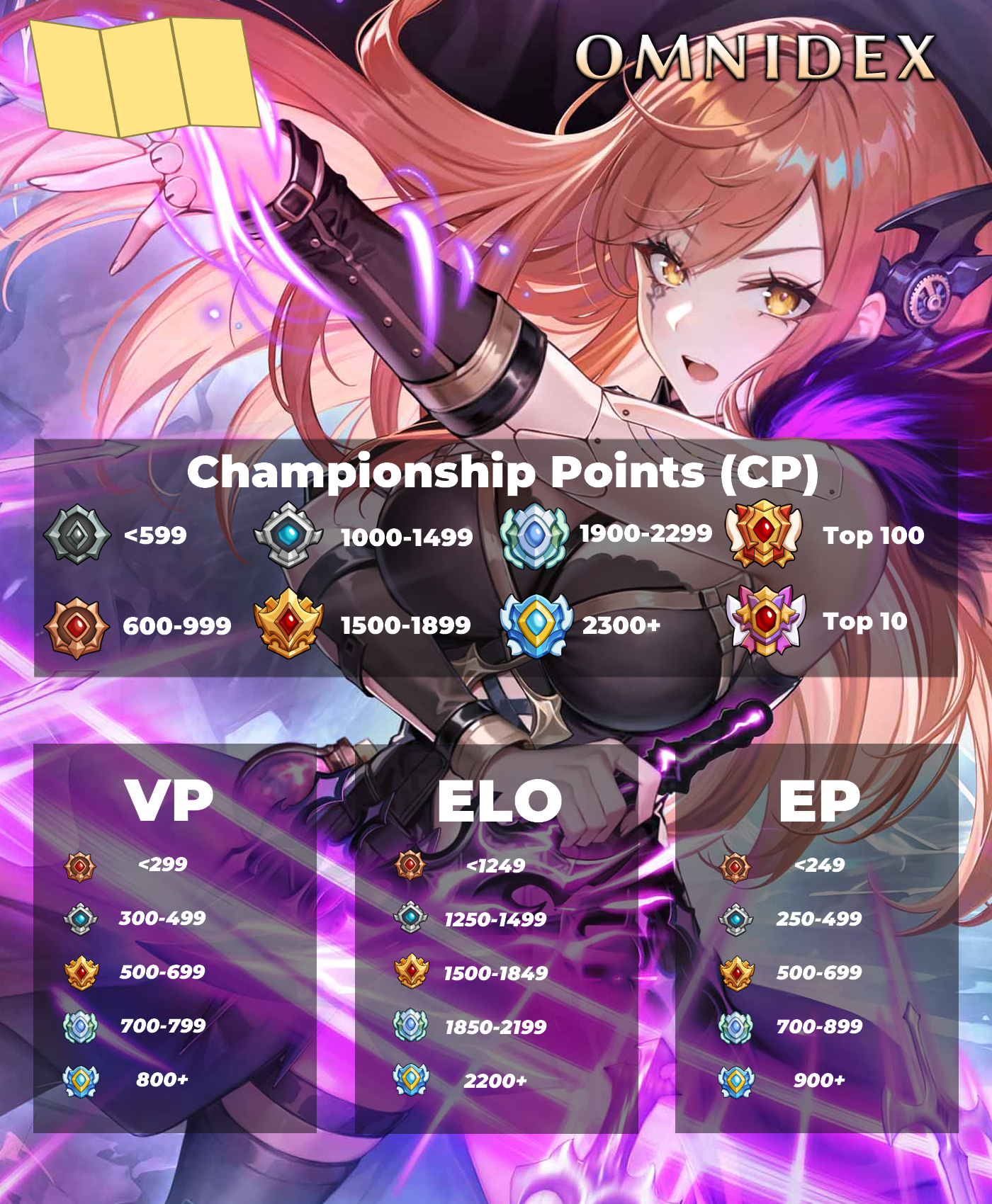
Omnidex rankings ranged from Unranked to Demigod, based on total Championship Points and leaderboard placement. Rankings are also assigned to each subcategory of points: VP, Elo and EP. The point thresholds listed on this chart were pulled from Omnidex in June of 2024, but are subject to change by Weebs of the Shore at their discretion. Ascendant and Demigod are special ranks, requiring that a player be AT LEAST Gold (1500 CP) and also in the Top 100 (Ascendant) or Top 10 (Demigod) players on the overall leaderboard.
For end of Season Omnidex rewards (in ALC and MRC seasons), a promotional card is awarded at Bronze, Silver, Gold and Ascendant rankings. These rewards are cumulative, with Ascendant players earning all 4 promo cards. In future seasons, we may see these rewards expanded. The current season rewards are always viewable within Omnidex by accessing the Season Guide.
The large rank badges only appear on your Omnidex profile. Event pages and Leaderboards use the "mini" version of the rank badges.
So, what's this darn "Elo" thing everyone talks about really?
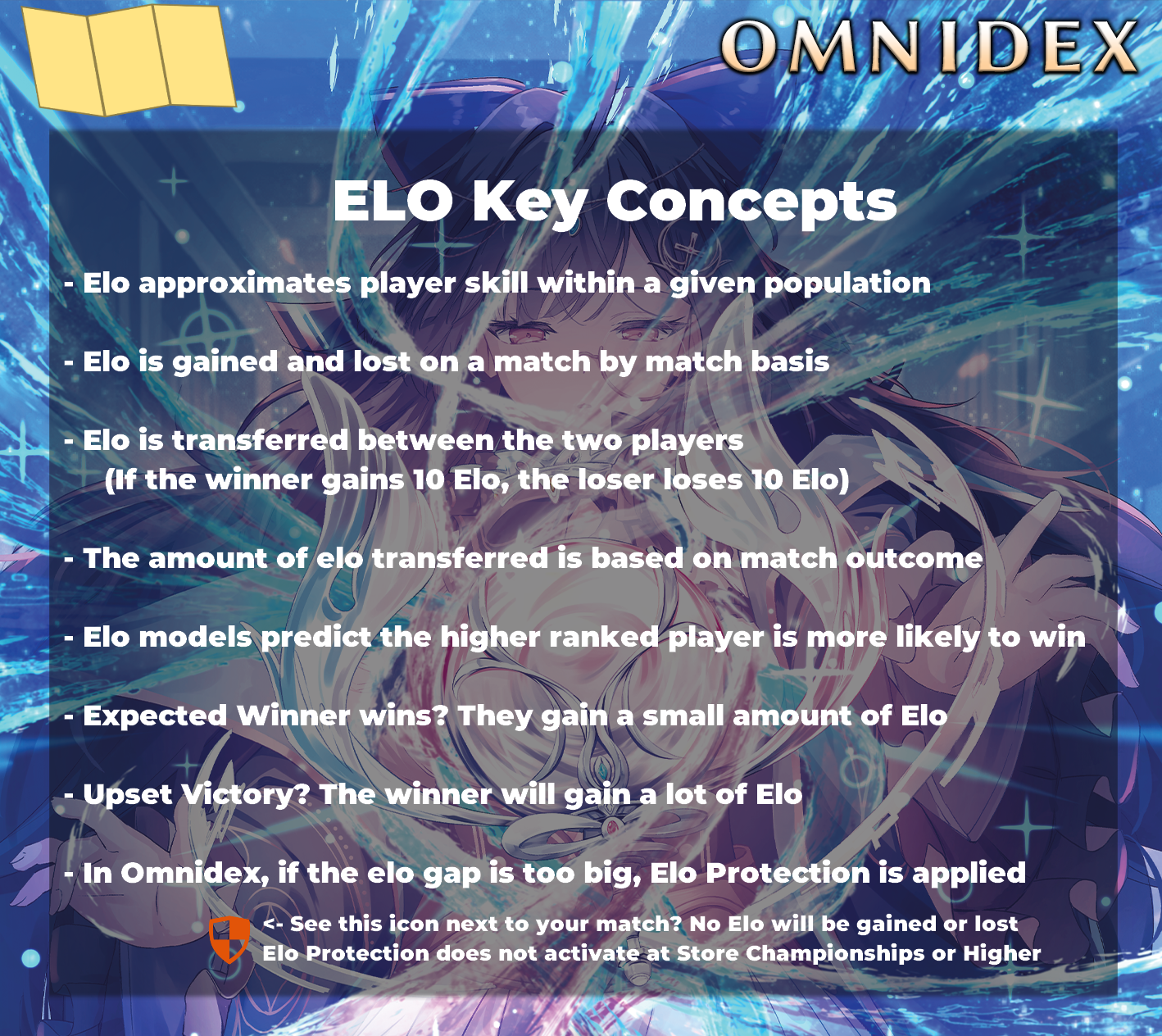
Let's dig a bit deeper into what Elo really is. Elo is a rating system, designed originally for chess, developed by Hungarian-American physicist Arpad Elo. Adapted from Chess into Grand Archive and many other games, online and off, Elo is a system used to measure player skill. All players are assigned a numerical rating, which fluctuates based on how they perform in competition. It is a measure which transcends the score of any single event, and is carried by the player throughout their career. A players rating can be used to compare with other players in the same population and is used to predict match outcomes. Many games, including Chess, use Elo for matchmaking purposes, to seed tournament pairings or as part of online game finders. Grand Archive does not use Elo for tournament matchmaking, but does use it for player ranking and season rewards.
Elo is gained and lost on a match by match basis. Generally speaking, winning causes a player's rating to increase, losing will cause it to decrease and draws will have minimal impact. The amount of Elo gained or loss depends on the match outcome and the difference in rating between the two players. An upset victory awards more Elo than a victory vs an evenly rated opponent. Elo is a zero-sum calculation. One player gains Elo after the match, and the other loses the same amount.
Some Omnidex events feature "Elo Protection". When enabled, matches between players with a large Elo gap will not result in any Elo changes, regardless of the match outcome. This can be seen next to match pairings as a small shield icon. Elo Protection is NOT enabled at premier level events.
We don't know for sure, but I suspect that Elo Protection activates at a gap of 200 or more points.
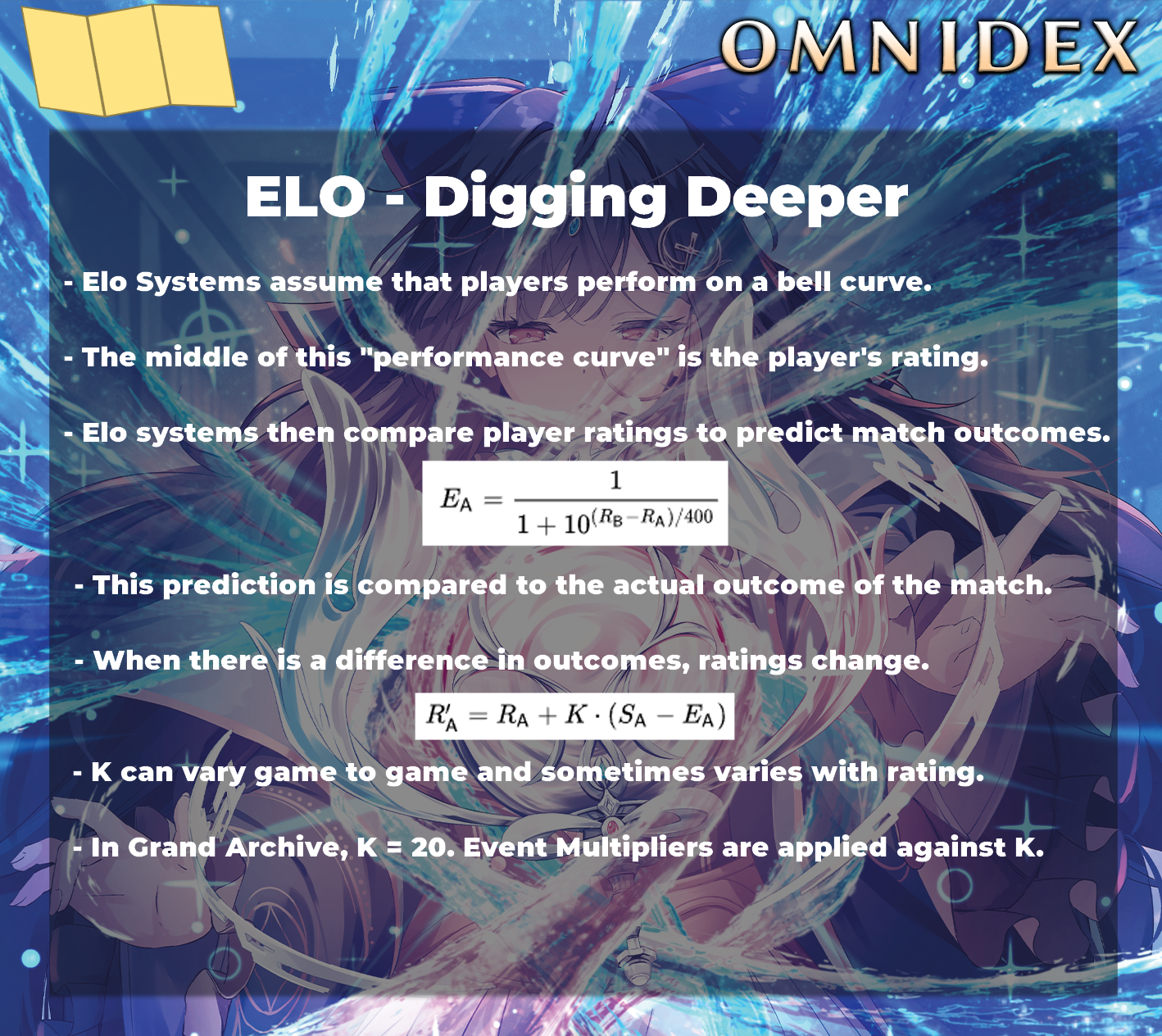
I've said that Elo predicts match results and ratings are adjusted after each match, but you may be wondering HOW exactly that works. So, lets dive into the math behind it.
Elo systems assume that players will perform on a bell curve. Some days you're locked in and play better than normal, and other days you are a little bit off and don't play so hot. In TCGs, the randomness behind what cards you draw can fluctuate as well, but on average, you will play at your 'normal' strength. Elo assigns a numerical value to this strength. A lower rated player can always beat a higher rated player, but this becomes less likely as the rating gap increases. Elo systems are designed so that a 400 point gap in rating indicates the higher rated player is 10 times likely to win as the lower rated player.
The first formula in the graphic is used to predict the match outcome for player A when compared against Player B, resulting in a value between 0 and 1, where 1 means the player will always win and 0 means the player always loses. Then, the actual outcome of the match is plugged into the second formula and player ratings are adjusted, to better reflect player skill and better predict match outcomes in the future. For this calculation, a win is worth 1 point, a draw is worth 0.5 points and a loss worth 0. The difference in actual result from the expected result is multiplied by K and added to the players previous rating to get a new rating. This means that K is the maximum amount a players rating can change from a single match. A K factor of 20 is common for many games, and 20 is what Omnidex uses, however K is also scaled by event multipliers. (At Locals, K is reduced to 4. At Nationals, K is increased to 25).
The K factor is the MAXIMUM Elo you can gain or lose per match. However, you would need to be rated SIGNIFICANTLY lower than your opponent and win that match to get the maximum value. Between Elo Protection (suspected to kick in at 200 point gaps) and the fact your opponents will not all be higher rated than you, in practice your Elo will change slower than the theoretical maximum.
Let's give a couple of examples:
Arthur (1250) and Galahad (1225) face each other at a locals event. Locals award 0.2x Elo (K = 4), and Arthur and Galahad have very similar ratings. Because they have similar ratings, the expected outcome is essentially a coin toss either way, albeit ever so slightly favored for Arthur. If they draw (the expected result), neither player will gain or lose any Elo. If a winner is declared, that player will gain 2 Elo and the other will lose 2 Elo.
Next round , Arthur (1252) faces off against Merlin (1400). This rating gap is more significant, and Merlin is favored 70 to 30. Should Arthur win, he will earn 3 Elo, and if he draws he will earn 1 Elo. If he loses, he will only lose 1 Elo.
In the final round at locals, Arthur (1255) faces off against Vanitas (1700). This is a massive difference in rating, and likely triggers Elo Protection. (If Elo Protection is not enabled, Arthur stands to earn 4 Elo for a win, 2 for a draw, and will not lose any for a loss).
Over the course of 3 rounds at locals, Arthur would have earned up to 9 Elo (ignoring Elo Protection on the last match). Keeping in mind that only 33% of your Elo is added to your total Championship Points, this amounts to an increase of 3 CP for Arthur.
Now Lets look at the same matches, but this time the battlefield is an Ascent (K=24):
Arthur (1250) vs Galahad (1225) - Arthur stands to win 11 Elo. A draw will cost him 1 Elo and a Loss will cost him 13 Elo.
Arthur (1261) vs Merlin (1400) - Arthur stands to win 17 Elo. A draw earns him 5 Elo and a loss costs him 7 Elo.
Arthur (1278) vs Vanitas (1700) - This is a premier event, there is no Elo Protection! Arthur stands to win 22 Elo. A draw earns him 10 and a loss only costs him 2 Elo.
In just 3 rounds, Arthur has earned 50 Elo and reached 1300! These 50 Elo are worth 16 CP! If Arthur keeps winning, he could walk away from Ascent Cambria with a significant Elo increase (and lots of EP)!
Locals are just for Fun! Don't worry about your Elo, you can't earn or lose much anyways! The real battleground is Premier Events!
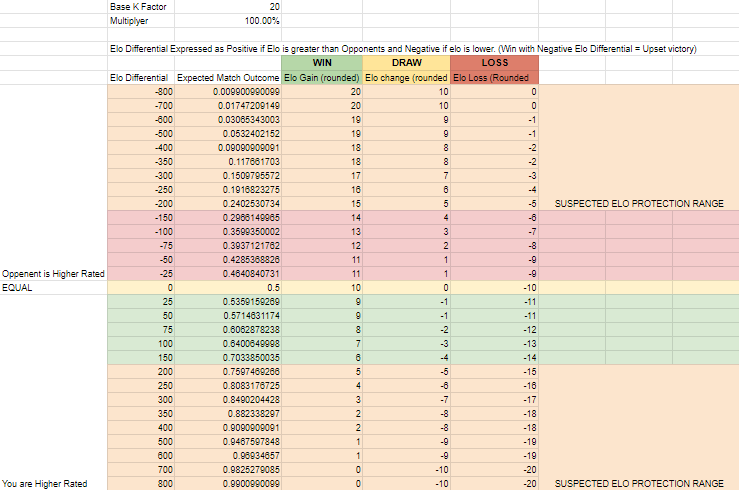
Thanks for reading to the end! Here's an Elo Table (make a copy to experiment with different Multipliers!) Google Sheet - GA Elo Table